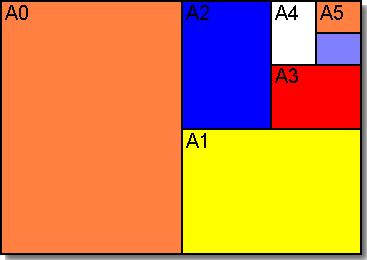In modern world, paper can be
purchased in a variety of sizes. It is a flexible material that can be cut in
any dimensions required. This variety of sizes however created standardisation
problems to the industries using paper as raw material. That lead to the
creation of standards sizes by different government organisations or
international standardisation institutes.
The majority of Europe
countries follow the standards created by DIN (Deutshes Institute for Normung.)
DIN organises the different paper sizes into series. Each series is named with
one or more letters (e.g. SRA) and each size in the series is named with a
number after the letters (larger numbers mean smaller sizes.)
 Each
series starts from a basic size which takes the number 0. The larger dimension
of the basic size is larger by the smaller by a factor of the square root of 2.
To find the next size in the series we divide the largest side of the current
size by 2. This side now becomes the smaller one. So the ratio of the two sides
is constant for every size. The figure on the side shows the relative sizes for
the series. It uses as an example the series A but the relatives sizes are the
same for every series following the DIN standards.
Each
series starts from a basic size which takes the number 0. The larger dimension
of the basic size is larger by the smaller by a factor of the square root of 2.
To find the next size in the series we divide the largest side of the current
size by 2. This side now becomes the smaller one. So the ratio of the two sides
is constant for every size. The figure on the side shows the relative sizes for
the series. It uses as an example the series A but the relatives sizes are the
same for every series following the DIN standards.
For sizes larger than the basic
one we multiply the smaller side by 2. The name of the size is the name of the
basic size preceded by a number showing how many time the size is larger than
the basic one. The total size of the paper shown in the above figure is 2A0.
Series
A
The
sizes in that series are the most widely used ones. Paper cut in these sizes is
used for writing, printing and photocopy. The series is created by a basic size
with an area of 1m2. The dimensions for each size in the series is shown in the
following table.
| Size |
Dimensions (mm) |
|
4A0
|
1682 X 2378
|
|
2A0
|
1189 X 1682
|
|
A0
|
841
X 1189
|
|
A1
|
594
X 841
|
|
A2
|
420
X 594
|
|
A3
|
297
X 420
|
|
A4
|
210
X 297
|
|
A5
|
148
X 210
|
|
A6
|
105
X 148
|
|
A7
|
74
X 105
|
|
A8
|
52
X 74
|
|
A9
|
37
X 52
|
|
A10
|
26
X 37
|
Series
B
These
sizes are used for papers with specialized uses than the ones in Series A.
Typical application for these sizes is printing of posters and maps.
|
Size
|
Dimensions
(mm)
|
|
4B0
|
2000 X 2828
|
|
2B0
|
1414 X 2000
|
|
B0
|
1000 X 1414
|
|
B1
|
707
X 1000
|
|
B2
|
500
X 707
|
|
B3
|
353
X 500
|
|
B4
|
250
X 353
|
|
B5
|
176
X 250
|
|
B6
|
125
X 176
|
|
B7
|
88
X 125
|
|
B8
|
62
X 88
|
|
B9
|
44
X 62
|
|
B10
|
31
X 44
|
Series
C
From that series are constructed the envelopes
in which we enclose documents printed on series A papers.
|
Size
|
Dimensions
(mm)
|
|
C3
|
324
X 458
|
|
C4
|
229
X 324
|
|
C5
|
162
X 229
|
|
C6
|
114
X 162
|
|
C7
|
81
X 114
|
Series
RA
These are the sizes of papers intended
for offset printing.
|
Size
|
Dimensions
(mm)
|
|
RA0
|
860
X 1220
|
|
RA1
|
610
X 860
|
|
RA2
|
430
X 610
|
Series
SRA
These sizes can be used as the initial,
untrimmed sizes for offset printing. The final printed document size can
be in A or B series.
|
Size
|
Dimensions
(mm)
|
|
SRA0
|
900
X 1280
|
|
SRA1
|
640
X 900
|
|
SRA2
|
450
X 640
|
_____________________________________________________________________
If
you experience any problem viewing these pages please inform us
at tepa@tepa.gr
Copyright © 2009
TEPA S.A.